Virtual Reality Statistics and Facts
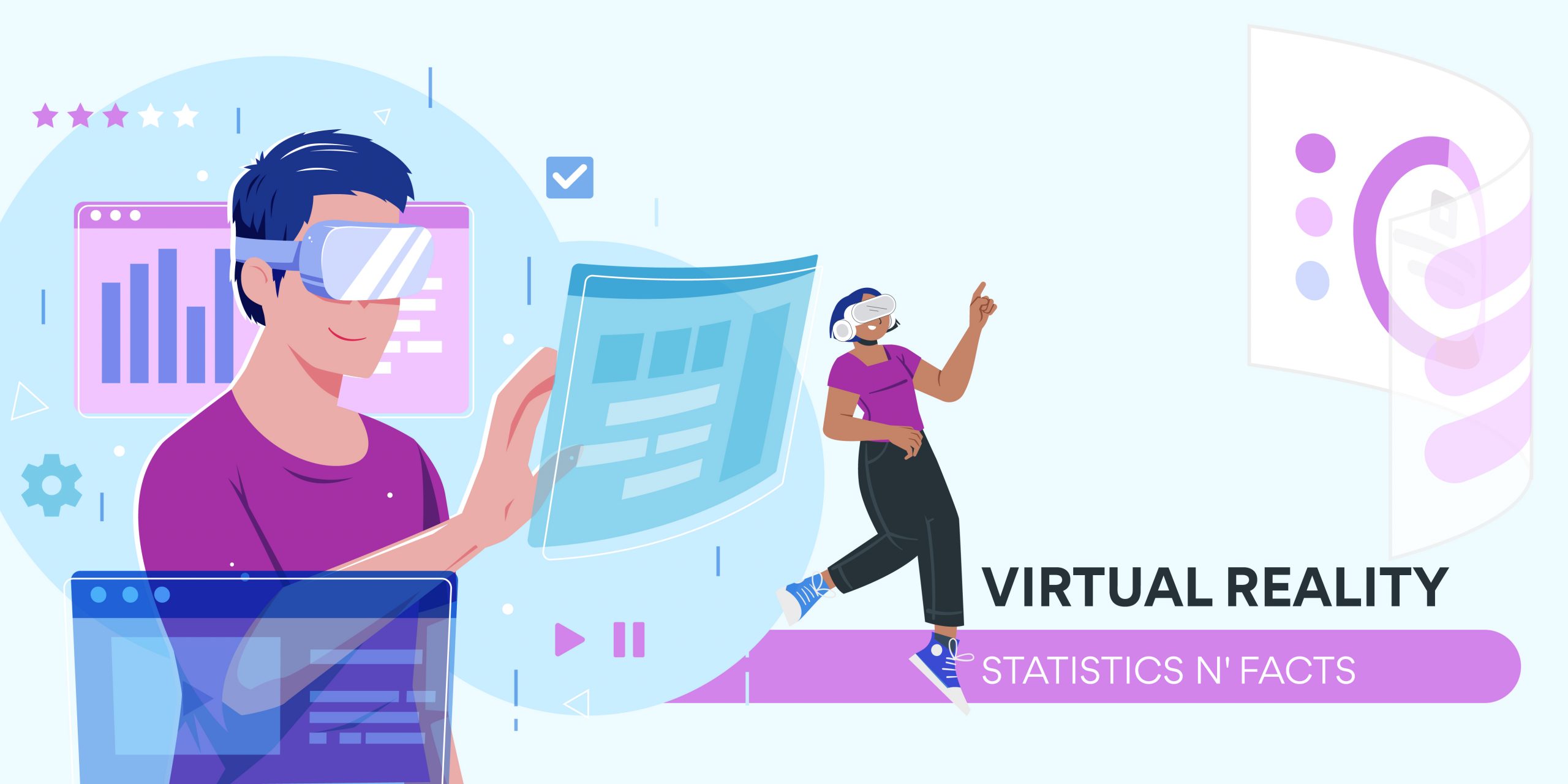
Page Contents
- Introduction
- Editor’s Choice
- Facts About Virtual Reality
- General Virtual Reality Statistics
- Virtual Reality Challenges
- Benefits of Virtual Reality
- Virtual Reality Statistics by Industry
- Virtual Reality Statistics by Country and Region
- Virtual Reality Statistics by Demographics
- Virtual Reality Statistics by Usage
- Virtual Reality Statistics by Market Leaders
- Virtual Reality Adoption Statistics
- Statistics by Virtual Reality Gaming
- Virtual Reality Statistics by Media
- Virtual Reality Market
- Conclusion
Introduction
Virtual Reality (VR) is a computer-made world that seems very real. It's made up of things and places that you can see and feel as if you were actually there. VR is split into three main types: fully-immersive, where you feel completely in the VR world; non-immersive, where you're partly in the real world and partly in VR; and semi-immersive, which is a mix of the two.
Looking ahead, by the year 2030, it's expected that in the United States, about 2.32 million jobs will be using VR. Also, the whole world's market for VR is predicted to reach a value of $26.9 billion by 2027, growing at a rate of 19% every year. These statistics show us how quickly VR is becoming popular all over the world.
Editor’s Choice
- VR Users in the U.S.: There are now 65.9 million people using VR (Virtual Reality) in the U.S., a 15% increase from 64 million in 2022.
- VR Gaming Market: The global VR gaming market was worth $12.13 billion in 2022. It's predicted to decrease to $5.44 billion by 2028.
- Cost Barrier in VR Adoption: 55% of people interested in VR think it's too expensive.
- VR Ownership in the U.S. (2023): 57% of VR users are male, and 43% are female. Among those planning to buy VR, 69% are male, and 31% are female.
- VR Gaming Revenue (U.S.): The revenue from VR gaming in the U.S. is expected to grow from $1.6 billion in 2022 to $1.9 billion in 2023, reaching $2.4 billion by the end of 2024.
- Global VR Spending (2024): The world's spending on VR technology might reach $72.8 billion by 2024.
- Global VR Users: There will be around 171 million VR users worldwide.
- VR Spending Breakdown (2024): Commercial spending on VR will be about $10.9 billion, while consumer spending will be higher at $17.6 billion.
- VR Users in the U.S. (2023): The U.S. has 70.8 million VR users, making up 21% of its population.
- VR in Education: By 2024, the VR in the education market is expected to reach approximately $13 billion.
- Enterprise VR Use: Enterprise use of VR for training and simulation is projected to grow significantly, potentially reaching a market size of $5.5 billion by 2023.
- Healthcare VR Market: The VR market in healthcare is forecasted to grow to $30.40 billion by 2026.
- VR in Retail: VR in retail is anticipated to see a compound annual growth rate (CAGR) of around 20% in the next few years.
- AR and VR Investment: Investments in AR (Augmented Reality) and VR startups have exceeded $2 billion, indicating growing interest and confidence in these technologies.
You May Also Like To Read
- Metaverse Statistics
- Artificial Intelligence Statistics
- Facial Recognition Statistics
- Machine Learning Statistics
- Quantum Computing Statistics
- NFT Statistics
Facts About Virtual Reality
- Market Growth and Value
- The global VR market size is estimated to grow significantly. It reached about $42.35 billion in 2023 and is projected to expand at a compound annual growth rate (CAGR) of approximately 33% between 2024 and 2032.
- By 2030, the VR market is expected to reach a substantial value of $165.91 billion, showcasing a CAGR of 31.0% from 2023 to 2030.
- Leading Companies
- Major players in the VR industry include Oculus (Meta Platforms), Google, Samsung, Sony, HTC, Lenovo, Microsoft, Unity Software, Qualcomm, Nvidia, and others.
- Notable developments include Apple planning to launch a mixed reality headset in 2023 and Sony's introduction of PlayStation VR2.
- Hardware and Software Segments
- VR hardware, software, and content are the primary components of the market.
- The hardware segment, which includes head-mounted displays (HMDs), VR simulators, glasses, treadmills, and haptic gloves, plays a significant role in the market.
- Industry Applications
- VR is increasingly used in diverse sectors like gaming, entertainment, healthcare, education, military and defense, and real estate.
- The gaming sector, in particular, continues to be a significant driver of VR technology adoption.
- Global Reach
- The VR market is expanding across regions, including North America, Europe, Asia Pacific, the Middle East and Africa, and Latin America.
- North America and Asia Pacific are notable for their significant contributions to the global VR market.
- Technological Innovations
- Companies are continuously innovating and developing new products, contributing to the growth and dynamism of the VR market.
- These innovations are not only enhancing user experience but also expanding VR's applications across different industries.
- Consumer Engagement
- The engagement in VR experiences is growing, with a notable proportion of consumers in the United States having had at least one VR experience.
- Interest in using VR for various purposes, such as work meetings, continues to rise, indicating a growing acceptance of VR in everyday activities
General Virtual Reality Statistics
- Usage in the U.S.: In 2023, over 70.8 million people in the U.S. use virtual reality (VR) at least once a month. This is a significant increase from 6.8 million users in 2022.
- Economic Impact by 2030: It's expected that by 2030, VR will contribute approximately $1.5 trillion to the global economy.
- Consumer Preferences: The main reasons people choose VR headsets are for the high-quality image (52%), comfort of the headset and controllers (44%), and superior audio system (39%).
- Market Size: The global market for VR hardware and software was valued at $4.6 billion in 2022, with expectations to grow to $5.1 billion in 2023.
- Business Adoption: In 2023, 30% of companies worldwide are integrating VR into their business strategies.
- Industry Leaders: Key players in the VR market include Meta, NVIDIA, Sony, Samsung, and HTC.
- Revenue by VR Type: In 2022, semi and fully-immersive VR technologies made up 82.7% of the revenue, while non-immersive VR accounted for 17.3%. The commercial VR segment earned 54.7% of the total revenue.
- Growth in Education Sector: VR is increasingly being used in education, with projections indicating a significant rise in its adoption for training and instructional purposes.
- Healthcare Applications: There's a growing trend of VR applications in healthcare for therapy, surgery simulation, and patient care training.
- Rise in Entertainment and Gaming: VR gaming continues to grow, with more immersive games and experiences being developed.
- Investment in VR Startups: Investment in VR startups has been increasing, indicating confidence in the future of the technology.
- Expansion in Retail and Real Estate: VR is gaining traction in retail and real estate for virtual tours and product demonstrations.
- Technological Advancements: Continuous improvements in VR technology, such as enhanced graphics and user interface, are driving its adoption.
- Global Expansion: VR technology is becoming more popular globally, with significant growth in markets like Asia and Europe.
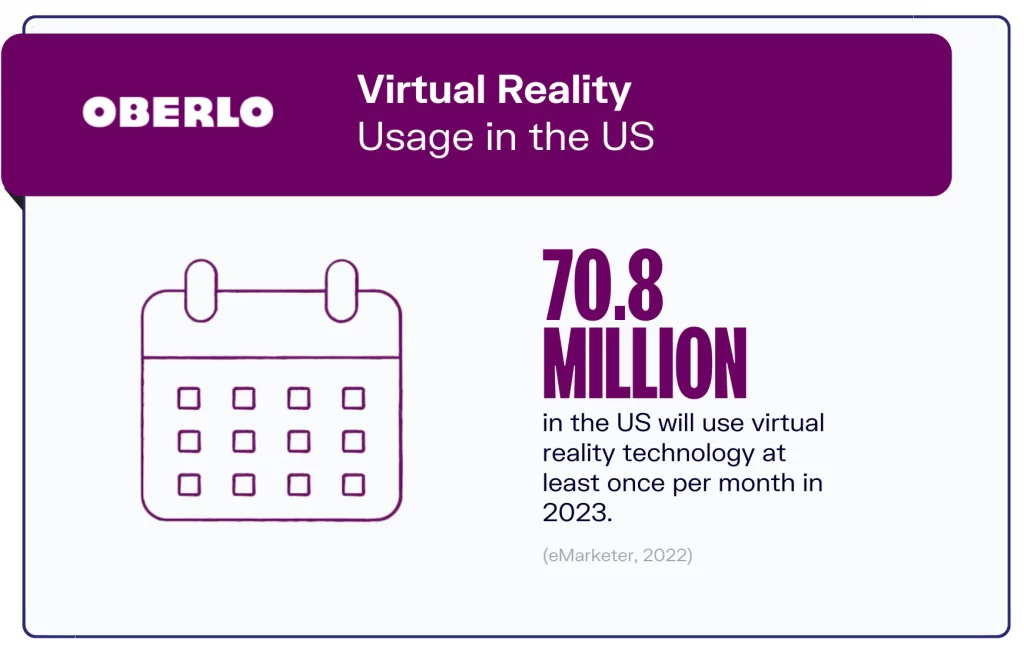 (Source: oberlo.com)
(Source: oberlo.com)
Virtual Reality Challenges
The challenges of Virtual Reality (VR), it's important to note that various factors are impacting its widespread adoption and usage. Beyond the issues of poor user experience, lack of content offerings, customer reluctance, regulatory risks, financing challenges, and cost considerations, there are other noteworthy points to consider:
- Technological Advancements: Efforts are being made to enhance VR headsets, focusing on improved resolution, field of view, and tracking accuracy. Haptic feedback and eye-tracking technologies are also being developed to make VR experiences more immersive.
- Software Developments: The VR software market is expanding rapidly, with new games, experiences, and applications being launched regularly. Developers are exploring new genres, including social VR, immersive storytelling, and educational simulations. The rise of cross-platform development tools is simplifying the creation of VR experiences for various platforms.
- Market Growth and Potential: The global spending on VR technology is projected to reach $72.8 billion in 2024, with an expected contribution to global GDP of $1.5 trillion by 2030. The healthcare sector, in particular, is leveraging VR for surgical planning, training, and education, with a projected growth of 38.7% reaching $6.2 billion by 2029.
- Consumer Interest and Demographics: Approximately 41% of adults express willingness to try VR, and over 60% of parents believe VR can offer educational content for their children. However, concerns about children's exposure to inappropriate content are significant. The primary demographic interested in VR devices is the 18-35 age group, with a notable majority of men showing intent to purchase VR systems.
- Social Engagement: A considerable percentage (nearly 80%) of VR users are seeking more social interaction, indicating a demand for more social engagement within VR experiences.
- Market Projections: The worldwide VR market is expected to reach $34.08 billion by 2023. North America is considered to have the best investment and growth potential in the VR sector.
- Industry Participation: Major tech companies like Google, Microsoft, Sony, and Samsung have made significant forays into VR technology. Microsoft's deal with the US Army for HoloLens headsets and Sony's success with PlayStation VR headsets are examples of significant industry investments in VR.
- Challenges for Startups: VR startups face challenges in innovation and product development due to the diverse quality range of available headsets and the technical limitations of current devices.
Benefits of Virtual Reality
- Real-Time Information Access: Nearly half (49%) of VR applications offer immediate data and insights.
- Training and Simulation: VR aids in training and simulating real-life scenarios, enhancing skill development.
- Creativity Boost: About 48% of VR use cases help in creative product development and design.
- Remote Work and Collaboration: VR enables 47% of its users to work and collaborate effectively from remote locations.
- Empathy and Experience Sharing: Approximately 41% of VR applications allow users to experience others' lives, promoting empathy and understanding.
- User Behavior Analysis: VR can track and analyze user behaviors like gestures and eye movements, used by 25% of applications.
- Market Growth: The virtual reality market is projected to grow significantly, with estimates suggesting a market size of over $22 billion by 2025.
- Educational Impact: In the educational sector, VR is increasingly being used, with significant market shares in regions like Asia-Pacific (37%) and North America (28%).
- Demographics: VR's primary users include millennials and Gen Z (30%), with interest in applications like virtual concerts and online shopping.
- Training Efficiency: VR training is found to be more emotionally engaging and effective compared to traditional methods. It's 3.75 times more emotionally connected and 275% more effective in skill application post-training.
- Consumer Interest: A significant percentage of adults (41%) express willingness to try VR if given the opportunity.
- Increased Employment Opportunities: VR technology is expected to create millions of job opportunities, significantly impacting employment by 2030.
- Diverse Applications: Beyond training and development, VR is also being used for enhancing soft skills and increasing empathy in customer service roles, as evidenced by its implementation in companies like H&R Block.
Virtual Reality Statistics by Industry
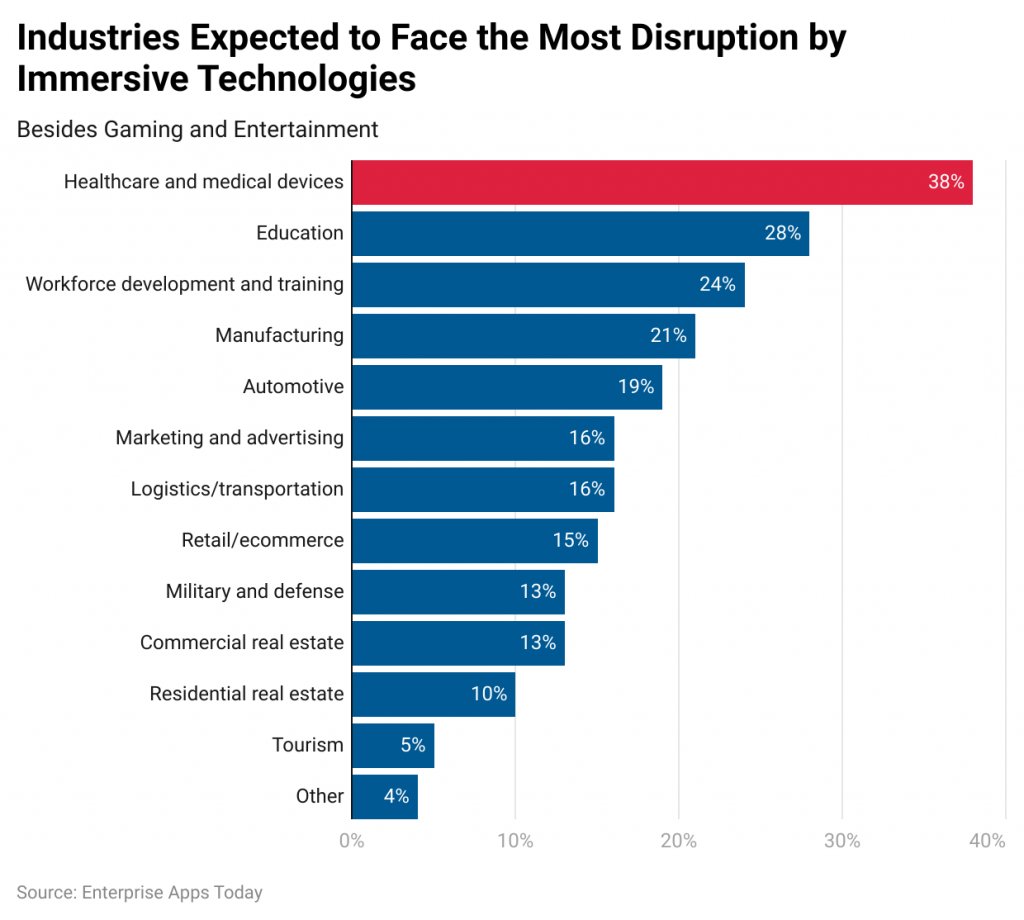 (Reference: 99firms.com)
(Reference: 99firms.com)
- In 2023, VR is most useful in gaming industries by 61% which is followed by healthcare and medical devices (38%) education (28%), workforce development and training (24%) manufacturing, and automotive (21% and 19% respectively), marketing and advertising (16%), logistics and transportation (16%), retail and e-commerce (15%), military and defense (13%), commercial real estate (13%), residential real estate (10%), tourism (5%), and others (4%).
- As of 2031, over the VR market, it is expected that the aviation industry is expected to be $23.6 billion.
- It is supposed that by the end of 2025 video entertainment, gaming, live events, and retail sectors of VR industries are going to hold half of the VR market.
- In 2022, VR used in the healthcare sector across the world resulted in $628 million, and by the year 2029, it is expected to be $6.20 billion.
- Whereas, by the end of the year 2026 the size of VR in the manufacturing industry is expected to be $14.8 billion.
- By 2027, the global virtual tourism industry is going to be $24 billion and in 2022 it will result in more than $6 billion.
- The VR-used retail industry is going to reach $19 billion by the year 2030.
Virtual Reality Statistics by Country and Region
- In 2022, the largest VR revenue share was accounted for by the Asia Pacific region resulting in 39%.
- Whereas, in 2023 the fastest growing VR market is Europe which has increased by 29.3% of CAGR.
- The leading countries that are currently investing in VR are China, the United States, the U.A.E, and France which worth $441.8 million by 2022 and the worth is expected to be $1,006 million by 2028.
- In the 1st quarter of 2022, the virtual reality market share of the educational industry in the different regions is followed by APAC (37%), North America (28%), Europe (19%), South America (12%), and rest of the world (4%).
Virtual Reality Statistics by Demographics
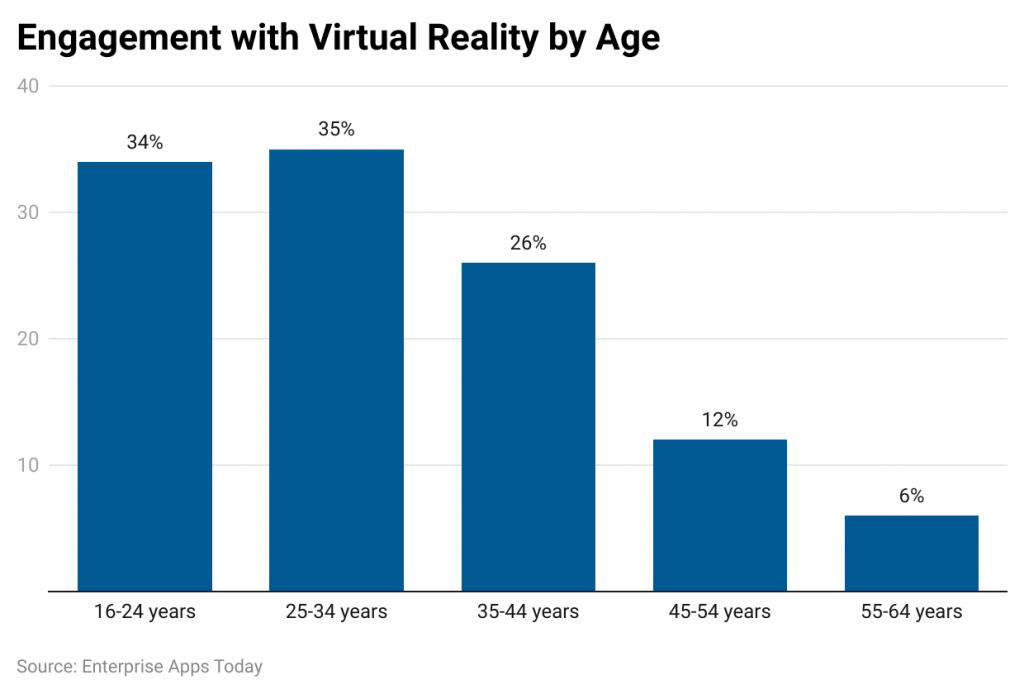 (Reference: 99firms.com)
(Reference: 99firms.com)
- As of 2023, in the U.S. the major VR users are 30% millennials and Gen Z, which is followed by Gen X (26%), and Boomers (13%).
- In the United States VR customers are very interested in attending virtual musical concerts which is followed by 37% of Gen Z and Millennials (38%).
- Virtual stores were preferred by 1 out of 3 Gen Z shoppers for purchasing products.
- In 2022 the virtual reality engagement statistics by age were followed by 25 years to 34 years (35%), 16 years to 24 years (34%), 35 years to 44 years (26%), 45 years to 54 years (12%), and 55 years to 64 years (6%).
- The VR motion sickness frequency statistics by gender are followed by male (7.2% frequently, 13.8% rarely, 29% sometimes, and 50% never) and female (22.8% frequently, 22.6% rarely, 20.2% sometimes, and 34.7% never)
Virtual Reality Statistics by Usage
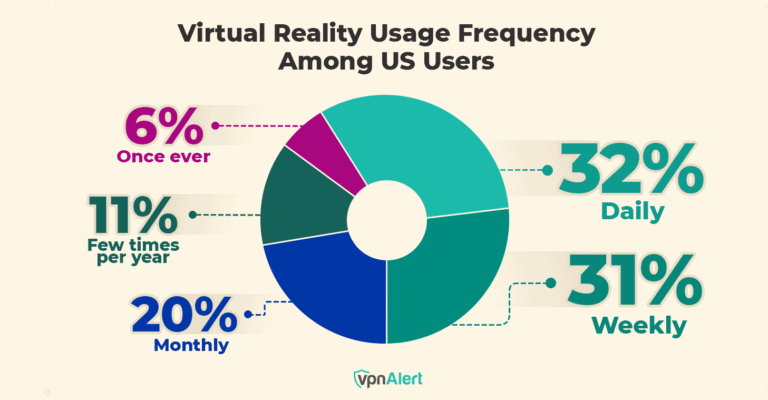 (Reference: vpnalert.com)
(Reference: vpnalert.com)
- In 2023, around 88% of VR headset users have used it many times per month, and 60% of users used it multiple times in a week.
- As of survey reports, 7 out of 10 users of VR headsets have used VR devices for playing games, and around 42% of owners of VR devices have watched TV or films.
- Continuously more than 1 hour was spent by 13% of VR headset users in 2023.
- In 2022, 40% of VR consumers felt very nervous after experiencing VR horror.
- On the other hand, 22% of VR headset owners have used VR devices for creating art, music, and videos while 35% of VR owners have used them for exercise and workout purposes.
Virtual Reality Statistics by Market Leaders
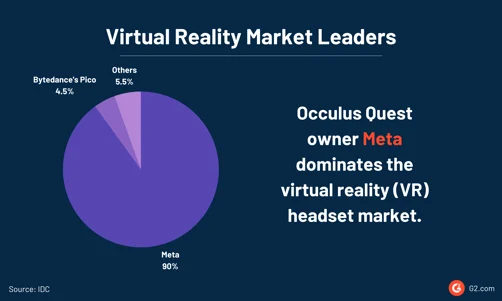
(Reference: g2.com)
- The VR market leaders offer immersive experiences over many global tech companies.
- Over the headset market of Virtual Reality, “Meta” is holding the highest share 90% in 2023.
- Followed by other leaders who are selling the best VR devices and experiences are ByteDance’s Pico (4.5%), and others (5.5%).
- From VR store Quest in 2023, revenue earned on apps and games ‘Meta’ has earned above $1.5 billion.
- On the other hand, ‘Oculus Quest VR headsets’ were sold by Meta resulting above 10 million units.
- In 2022, the market leaders of VR are Oculus VR LLC, Unity Technologies Inc., Lenovo Group Ltd., Samsung Electronics Co. Ltd., and Sony Corporation.
- In the 1st quarter of 2022 the sales rate of VR headsets increased by 241.6% in the United States alone and by the end of the year it turned out to be 13.9 million.
- By the end of 2026, VR headsets will be sold by 73.6 million around the global market.
Virtual Reality Adoption Statistics
- In 2023, the global users of VR technology are expected to be 171 million.
- The commercial VR purchases are going to be $ 10.9 billion in 2023 whereas, the amount of consumer spending will be $17.6 billion in 2024.
- According to virtual reality statistics, it has been observed that once after trying the VR devices the interest rates have grown effectively.
- In 2022, the United States 53 million people owned VR systems, and 1/3 of teens that is 26% of the U.S. have owned VR devices.
- Users are adopting VR devices for visiting virtual art galleries or museums (39%), attending yoga or fitness courses (32%), and staying connected with family and friends (31%).
- In the last two quarters of 2022, around 14 million U.S. adults have purchased VR devices and the spending of VR users has increased by 35%.
- At least one VR headset was used by 13% people of United States.
- It is expected that by the end of 2024, almost 34 million people are going to adopt VR headsets.
- Almost half of the businesses and users are ready to pay extra for adopting advanced VR technologies.
Statistics by Virtual Reality Gaming
- In 2022, more than 50% of consumers across the world have purchased VR devices for playing games.
- According to expert estimates in the 3rd quarter of 2022, around 471,000 Oculus Quest 2 VR were sold by Meta.
- Sony Corporation has estimated that by the end of 2023, the second edition of the PlayStation was sold by 2 million units.
- In the United States in 2022, the revenue of VR gaming has grown by $1.6 billion, and by the end of 2023 the revenue is expected to be $1.9 billion and by 2024 it will be $2.4 billion.
- Whereas, more than 500,000 VR devices were sold by Pico in the 1st quarter of 2022.
- By the end of 2022, revenue earned by 1/3rd of Meta’s 400 VR games resulted above $1 million.
- “The Walking Dead: Saints and Sinners” is a popular Meta VR game that has earned more than $50 million in revenue.
- In the coming days, the gaming industry will enhance more enormously by implementing the combination of both VR and AR technologies said by 52% of the U.S. gamers.
Virtual Reality Statistics by Media
- In the 1st half of 2022, almost 1/3rd of VR users have linked with VR platforms after browsing them on VR stores.
- The most famous VR social media platform named “Roblox” has experienced more than 58.8 million daily active users and spent 13.4 billion hours in 2022.
- According to VR gaming industry statistics, 50% of Roblox’s daily users were aged less than 13 years.
- Whereas, 31% and 19% of VR users have purchased digital products and luxury items respectively from VR social media platforms.
- The conversion rates have increased by 94% when products are marketed with VR content.
- 70% of adults and 61% of young shoppers across the world have preferred brands that are linked with VR technologies.
- In the case of selecting a tourist destination, 1/4th of tourists have planned to use virtual reality in 2023.
Virtual Reality Market
- In 2023 the startups of VR have increased by 14% from last year.
- On the other hand, Apple Company has planned to launch VR headsets which determined that the interest in VR technologies has increased.
- The global number of users of VR technology is expected to be 171 million by 2022.
- In the United States, there are more than 950 VR startups of which 85% are actively working on VR projects.
- As of now, VR technology is familiar among 78% of Americans. Brands that the
Conclusion
As of today after completing the article on Virtual Reality Statistics it has been easily stated that the VR world for all of us is not happening yet. It has been observed that in the U.S. only 25% of internet users are expected to use VR.
The concept of VR is still new to the world’s mainstream market. With each passing year, the VR industry is growing effectively and different sectors have achieved positive growth. This article includes several effective statistics that will help in understanding the topic better.
Sources
FAQ.
The technologies are motion sensors and gyroscopes for tracking body head, and hand positions; small HD screens for stereoscopic display, and fast, lightweight and small computer processors.
As of 2023, the biggest VR worldwide companies are Microsoft, Google, Oculus, HTC Vive, Sony, Samsung, and Magic Leap.
Virtual reality was created by an American computer scientist named Ivan Sutherland and his student named Bob Sproull in the year 1968.

Barry is a lover of everything technology. Figuring out how the software works and creating content to shed more light on the value it offers users is his favorite pastime. When not evaluating apps or programs, he's busy trying out new healthy recipes, doing yoga, meditating, or taking nature walks with his little one.